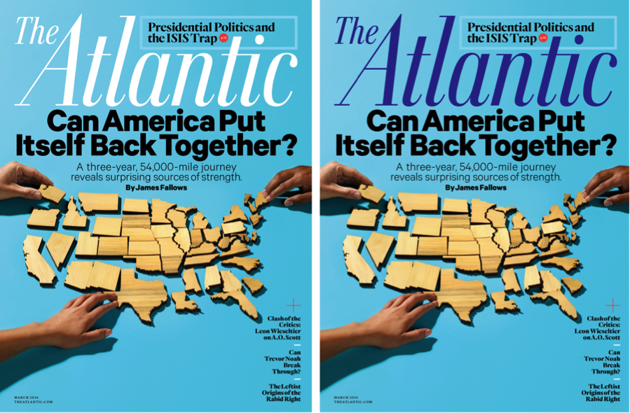
Next week a cover story whose writing and editing has tied me up for quite a while, and whose reporting has engaged my wife Deb and me over the past few years, will come out in print and on line. (Subscribe!)
Just now Darhil Crooks, creative director of the newly crowned Magazine of the Year, described the process by which he came up with a very nice cover image — plus the interior layout of the story. You can read it here. One of the great satisfactions of magazine journalism is the coming-together of many different kinds of imaginative talents and sensibilities. Part of Darhil Crooks’s genius is being able to move from an editor-level grasp of the argument and tone and ambition of a written story, to the right photographic, layout, illustration, cover-design, and other graphical means through which the message can be conveyed and enhanced. It’s like a good words-and-music combo, in that the pairing seems “natural” or even “inevitable” once you’ve heard or seen it, but (in my case) I could never have imagined it before knowing what the design team has figured out.
As a preview to the piece, here is the “dek,” the summary on the opening page:
Most Americans believe the country is going to hell. They’re wrong. What a three-years journey by single-engine plane reveals about reinvention and renewal—and about how the Second Gilded Age might end.
And here is an intermediate passage on the rationale behind this venture:
There is a high-toned tradition of road trips as a means of “discovering” America, from Lewis and Clark and Tocqueville through John Dos Passos, John Steinbeck, and William Least Heat Moon (whose Blue Highways made its debut in these pages). Apart from other obvious points of contrast, our project was different in that rather than going by car (or wagon, or pirogue), we’ve gone from city to city in our family’s small single-engine propeller airplane, a Cirrus SR22. This was a decision made for convenience, for beauty, and for edification….
The beauty comes from the privilege and unending fascination of watching the American landscape unfurl below as you travel at low altitude. At the dawn of powered flight, a century ago, it was assumed that writers and painters would want to become aviators, and vice versa…
A coast-to-coast drive across America has its tedious stretches, and the teeming interstate corridors, from I-95 in the east to I-5 in the west, can lead to the despairing conclusion that the country is made of gas stations, burger stands, and big-box malls. From only 2,500 feet higher up, the interstates look like ribbons that trace narrow paths across landscape that is mostly far beyond the reach of any road. From ground level, America is mainly road—after all, that’s where cars can take you. From the sky, America is mainly forest in the eastern third, farmland in the middle, then mountain and desert in the west, before the strip of intense development along the California coast.
It’s also full of features obvious from the sky that are much harder to notice from the ground (and difficult to pick out from six miles up in an airliner): quarries at the edge of most towns, to provide gravel for roads and construction sites; prisons, instantly identifiable by their fencing (though some mega high schools can look similar), usually miles from the nearest town or tucked in locations where normal traffic won’t pass by. I never tire of the view from this height, as different from the normal, grim airliner perspective as scuba diving is from traveling on a container ship.
More to come about the magazine piece, and some new online accompaniments, next week. That is what will keep me busy over the weekend.
Update: Please read on for a new photo contest concept.
***
Announcing: The View From Your (Airplane) Window.
Loyal readers of Andrew Sullivan’s The Dish, for many years part of our Atlantic online family, know and miss its “The View From Your Window” feature. Here’s a wonderful post by Andrew from ten years ago, when the first few photos were trickling in. During Andrew’s time with the Atlantic, TVFYW became the basis of a very popular contest, which lasted through the remaining years of The Dish.
Chris Bodenner, now the impresario of our Notes section, was one of the stalwarts of the Dish team during its Atlantic era and afterward. He has proposed an updated “The View From Your Airplane Window” feature, in keeping with the emphasis on “the aerial view” you see quoted above.
Shots from airplane windows were an occasional part of the prior TVFYW feature. We’d like to concentrate on collecting aerial shots only — from small planes and airliners, from helicopters and airplanes, from altitudes high enough to reveal large-scale geographic patterns and low enough to display surprising neighborhood or city-planning details.
Chris will be back next week to explain more about the concept and structure of the feature and the contests. (For instance: do drone shots count? Argument for: they can be very interesting aerial views. Argument against: no window. Which naturally raises the question: are windows really necessary? What about views from wing-suits, or hang-gliders, or balloons? Chris will figure all this out.)
In the meantime, please begin sending him any relevant photos, with identifying info— when, where, how, and what’s interesting about what we’re looking at. You can find Chris at hello@theatlantic.com.
***
Furthermore on the aerial-view theme, here’s another look at our upcoming cover, this time in motion, courtesy of the Atlantic’s photo whiz Alan Taylor:
@jameshamblin@AdrienneLaF@TheAtlantic@darhilcrooks@JamesFallows One more attempt - as a gif: pic.twitter.com/S8JXPhTqE1
— The Atlantic Photo (@TheAtlPhoto) February 5, 2016